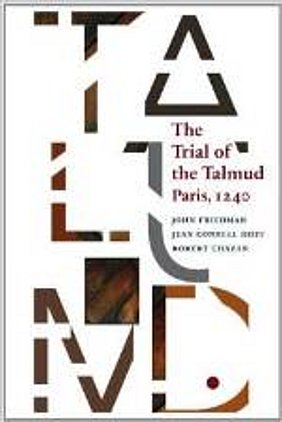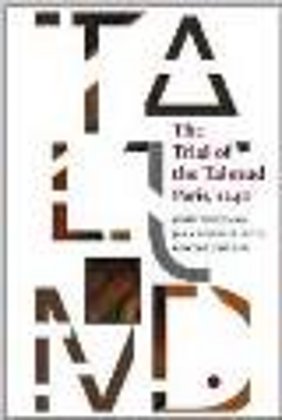In June 1239, Pope Gregory IX prompted an investigation about the Talmud (papal bull Si vera sunt) at the behest of the French convert Nicolas Donin. The charges against the Talmud included the falsehood of its purported Mosaic origin and the fact that it contained blasphemies against the Christian religion, hostile statements against Christians, illogicalities, and obscenities. The investigation culminated in the Paris trial of 1240, which was followed by the confiscation and burning of large numbers of Talmudic manuscripts in 1241 (or 1242). Similar events followed until the discussion of 1248 between Pope Innocent IV and his legate in France, Odo of Châteauroux, when the politics of the church about the Talmud started shifting from overt persecution to rigorous censorship.
A new volume in the series Mediaeval Sources in Translation from the Pontifical Institute of Mediaeval Studies in Toronto offers readers the first complete English translation of the Latin and Hebrew sources for the 1240 Paris trial of the Talmud. The book consists of three parts: a lengthy ninety-two-page historical essay by Robert Chazan (“Trial, Condemnation, and Censorship: The Talmud in Medieval Europe”) providing historical background and context, Jean Connell Hoff’s translation of the Latin sources, and John Friedman’s translation of the Hebrew literary account of the trial. The introductory essay recapitulates and updates the great amount of extremely important research that Chazan has dedicated over more than four decades to the Paris trial and to the Jewish presence in early Capetian France, starting from his pioneering Medieval Jewry in Northern France: A Political and Social History, and until Reassessing Jewish Life in Medieval Europe, including in particular his essay “The Hebrew Report on the Trial of the Talmud: Information and Consolation.”[1] Chazan’s presentation and classification of the charges that Donin leveled against the Talmud is the first attempt at a systematic comparison between the Latin sources and the Hebrew account and to make sense of their relevant differences.
Some interesting aspects of the Talmud affaire seem not to have been granted adequate attention. The most surprising among the few events in Donin’s biography that we know for sure—that is, the eleven years he spent after leaving (or being expelled from) the Jewish community in 1225 and before being baptized by Gregory IX in 1236—is given no relevance.[2] It is also worth observing that the sources about the Paris trial are the first documents from northern Europe where Jewish criticism against Jesus is based on direct knowledge of the New Testament; the few earlier testimonies of such knowledge come from the Levant, Spain, and Provence (Sefer Nestor ha-Komer “Book of Nestor the Priest,” tenth century), Ya‘aqov ben Re’uven’s Milhamot ha-Shem “The Wars of the Lord," twelfth century, and Me’ir of Narbonne’s Milhemet mitzwah "War by Commandment,” mid-thirteenth century).[3] (Philippe Bobichon kindly informs me that his broad essay on MS Paris, Bibliothèque Nationale, Hébr. 712—written not long after 1240 and containing both the Wikkuah Rabbenu Yehi’el "The Disputation of Our Rabbi Yehiel" and an anthology of passages from the New Testament in Latin transliterated into Hebrew script—is forthcoming in the series Bibliothèque de l’Ecole Pratique de Hautes Etudes.) Lastly, no mention is made of the great attention that Rashi’s commentaries on the Bible and the Talmud were granted during the debate according to both the Latin sources and the Hebrew account: the Paris trial was actually not just against the Talmud alone, but against the whole rabbinic canon, inclusive of Rashi’s commentaries.[4]
The recent, extraordinary vitality of research in this realm is shown by the fact that the bibliography of the volume, though very rich and up-to-date, is nonetheless already in need of some integration.[5] Another aspect of the whole issue that still lacks adequate consideration is the synergy between the church and the French state in the Parisian affaire and its aftermath, as much as—in general—the role that public anti-Jewish polemics and disputations played in the competition among different political powers that was taking place on the European scene in the mid-thirteenth century. Louis IX’s being “very pious” (p. 89) does not completely account for the fact that he was the only Western king to answer the pope’s call to investigate the Talmud. The events in Paris took place at the convergence of two distinct, even opposite, political and social trends: on the one hand, Paris was in the midst of a crisis of imperial power and feudalism, which led to the church to attempt to redirect attention to the ideological invention of new “other” enemies (heretics and Jews); on the other hand, the new urban bourgeoisie of merchants and craftsmen—the very force disrupting imperial power and feudalism—was not yet so strongly established as to evolve into a fully pluralist urban (or statal) society that could be inclusive of such “others” as the Jews. On the contrary, Jews were perceived as competitors in the field of trade and finance; therefore, the emerging bourgeoisie granted support to the church’s anti-Jewish policy.[6]
The English translation by Hoff of the Latin sources about the trial and its aftermath are mostly contained in MS Paris, Bibliothèque Nationale, Lat. 16558. For obvious reasons of space, this excellent translation of the Latin sources (with due indications and emendations of erroneous readings in the manuscripts) does not include the most important and still unpublished Latin document related to the Paris trial: the Extractiones de Talmut, a lengthy dossier (contained in MS Paris Lat. 16558, ff. 1a-211a) of Talmudic passages translated into Latin that became the object of Christian criticism. This huge corpus, a crucial part of the sequence of intellectual and political events that culminated in the Paris trial, is now finally being investigated and edited through the research project on The Latin Talmud and Its Influence on Christian-Jewish Polemics (European Research Council Consolidator Grant 2013) directed by Alexander Fidora.
Friedman provides the English translation of Wikkuah Rabbenu Yehi’el, the Hebrew literary account of the trial, with succinct notes. The well-known elegy Sha’ali Serufah Ba-esh (Ask, o thou who have been burnt in fire) by Me’ir of Rothenburg (not Rothenbergas, mistakenly repeated on pages 23 and 169), on the burning of the Talmud which followed the trial, is also translated in an appendix. From a rhetorical and stylistic perspective, the Wikkuah Rabbenu Yehi’el is an exceedingly difficult text, packed with melitzah, “elegant language”; Friedman’s effort at translating is thus all the more to be appreciated. Friedman’s translation is also the first complete one in any modern language, after a faulty one by Morris Braude (Conscience on Trial: Three Public Religious Disputations between Christians and Jews in the Thirteenth and Fifteenth Centuries), Hyam Maccoby’s unhelpful summary (Judaism on Trial: Jewish-Christian Disputations in the Middle Ages), and a partial French translation by Henri Kahn and Alex Klein (“Le ‘brûlement’ du Talmud en Place de Grève: 750 ans”).[7] This part of the book fills therefore a serious scholarly void.
Some shortcomings in the translation have already been signaled for future reprints by Daniel J. Lasker in Journal of Jewish Studies.[8] Here are a couple more. About the tradition of Mary “the dresser of women’s hair,” i.e., Mary Magdalene (p. 137n25), it is worth calling attention to the pun in the Hebrew text, where the epithet megaddelah, “hairdresser,” is also an assonant, derogatory deformation of Latin Magdalena. At the beginning of the judicial hearing, the Hebrew li-qro’ ehad ahuz min ha-arba‘ah, referred to Donin, is rendered as “to read aloud one percent of the Talmud” (i.e., the four Divisions of the Babylonian Gemara) (p. 128), whereas it is much more likely to mean “to summon to testimony [only] one taken from the four,” where the “four” are the rabbis present in the court and mentioned by their names only a few lines above, and the “one” is Rabbi Yehi’el, the only rabbi who spoke on behalf of the Talmud during the trial (as stated immediately further: wayyiqra’... ha-rav r. Yehi’el hu’ levado “and he summoned Rabbi Yehiel by himself”).
The controversial issue of the textual transmission of the Wikkuah is granted no attention in the book. No mention is made of the aforementioned MS Paris Hébr. 712, the most ancient witness to the text, and the one transcribed (with many errors) by Samuel Grünbaum for his edition (1873), whose text is translated by Friedman. Chazan mentions three manuscripts and points out that MSS Paris and Moscow (Rossiiskaia Gosudarstvennaya Biblioteka, Günzburg 1390) do not differ greatly from Donin’s charges against the Talmud and Yehi’el’s answers. The textual witnesses of the Wikkuah are actually seven (I am presently working on a critical edition) and the Paris and Moscow MSS are nonetheless quite divergent as to the procedure of the trial and various other details (for instance, King Louis IX never attended the debate according to MS Paris, whereas two passages of the Moscow MS seem to suggest that in some instances he might have been present[9]). The passage from Isaiah 46:1 discussed in the Wikkuah (p. 147n194) can only be understood in view of a joke in early French vernacular (la‘az) contained in Rashi’s commentary to the bibical verse, sarcastically quoted by Donin, reported in the Paris MS (as in all the other ones), but not transcribed in Grünbaum’s edition due to its foul language, and thus absent from Friedman’s translation, too.[10]
This volume is an excellent and up-to-date tool (especially convenient for classes) on the Paris Talmud trial and its aftermath and on Jewish-Christian polemics in the Middle Ages in general, for both an academic and a nonacademic readership. In particular, we still have much to learn from research on the events of 1240 and the related Hebrew account.



